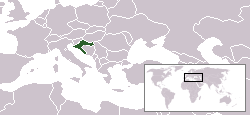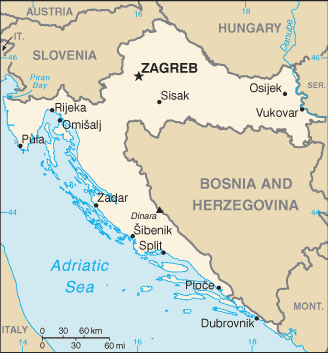Croatia
The Republic of Croatia is a crescent-shaped country in Europe bordering the Mediterranean, Central Europe and the Balkans. Its capital is Zagreb. In recent history, it was a republic in the SFR Yugoslavia, but it achieved independence in 1991. It is a candidate for membership of the European Union.
Republika Hrvatska | |
|---|---|
| Motto: none | |
| Anthem: Lijepa naša domovino | |
 | |
| Capital and largest city | Zagreb |
| Official languages | Croatian (locally also Italian) |
| Government | Democratic republic |
| Independence | |
• Water (%) | 0.01% |
| Population | |
• July 2004 estimate | 4,496,869 (117th) |
• 2001 census | 4.437.460 |
| GDP (PPP) | 2005 estimate |
• Total | $55,638 million (72nd) |
• Per capita | $12,364 (56th) |
| Currency | Kuna (kn) (HRK) |
| Time zone | UTC+1 (CET) |
• Summer (DST) | UTC+2 (CEST) |
| Calling code | 385 |
| ISO 3166 code | HR |
| Internet TLD | .hr |
History
Main article: History of Croatia
The Croats are a Slavic-speaking people who lived in an area of what is today Galicia (in Ukraine and Poland). From there they migrated further south to present-day Croatia during the 7th century. Nominally under East Roman and then Frankish authority, Croatia eventually became one of the most powerful kingdoms in the region, but in 1102 the Croatians ended a decade-long dynastic struggle by agreeing to submit themselves to Hungarian authority.
By the mid-1400s, the Hungarian kingdom was gravely impacted by the Ottoman expansion and much of the mountainous country now known as Bosnia and Herzegovina fell to the Turks. At the same time, Dalmatia became mostly Venetian. Dubrovnik was a city-state that was firstly Byzantine (Roman) and Venetian, but later, unlike other Dalmatian city-states, it became independant as Republic of Dubrovnik, even if it was often under the suzerainity of neighboring powers.
The Battle of Mohács in 1526 led the Croatian Parliament to invite the Habsburgs, under Ferdinand I, to assume control over Croatia. Habsburg rule eventually did prove to be successful in thwarting the Ottomans, and by the 18th century, much of Croatia was free of Turkish control. Istria, Dalmatia and Dubrovnik all eventually passed to the Habsburg Monarchy between 1797 and 1815.
Following World War I and the demise of Austria-Hungary, Croatia joined the Kingdom of Serbs, Croats and Slovenes (which became Yugoslavia in 1929). Yugoslavia was invaded during World War II and Croatia was made into a fascist puppet-state named the Independent State of Croatia. After the defeat of the Axis powers, Yugoslavia became a federal socialist state under the strong hand of Josip Broz Tito.
Although Croatia declared its independence from Yugoslavia in 1991, it had to endure four-to-five years of sporadic and often bitter fighting with the Yugoslav People's Army and the Army of the internationally unrecognized Republic of Serbian Krajina. The Croatian major offensives in 1995, Operation Storm and Operation Flash, defeated the separatists and ended the war, restoring the territories of Krajina to Croatia. Between 1992 and late 1995, various Croatian forces were also involved in the war in Bosnia and Herzegovina. Peaceful integration of the remaining separatist territories was completed in 1998 under UN supervision.
Croatia applied for European Union membership in 2003 and the EU leaders accepted it as an official candidate country in 2004. As of March 2005, Croatia's candidacy was put on indefinite hold due to Carla del Ponte's assertion that Zagreb had not fully cooperated with the International Criminal Tribunal for the former Yugoslavia with regards to the apprehension of the fugitive alleged war criminal and former General, Ante Gotovina.
Politics
Main article: Politics of Croatia
Since the adoption of the 1990 Constitution, Croatia has been a parliamentary democracy.
| Croatia is a member of: |
| United Nations |
| Council of Europe |
| OSCE |
| Partnership for Peace |
| Other organizations |
The President of the Republic (Predsjednik) is head of state and elected for a five-year term. In addition to being the commander in chief of the armed forces, the president has the procedural duty of appointing the Prime minister with the consent of the Parliament, and has some influence on foreign policy.
The Croatian Parliament (Sabor) is a unicameral legislative body of up to 160 representatives, all elected by popular vote to serve four-year terms. The plenary sessions of the Sabor take place from January 15 to July 15, and from September 15 to December 15.
The Croatian Government (Vlada) is headed by the Prime minister who has 2 deputy prime ministers and 14 ministers in charge of particular sectors of activity. The executive branch is responsible for proposing legislation and a budget, executing the laws, and guiding the foreign and internal policies of the republic.
Croatia has a three-tiered judicial system, consisting of the Supreme Court, county courts, and municipal courts. The Constitutional Court rules on matters regarding the Constitution.
See also: Foreign relations of Croatia
Counties

Main article: Counties of Croatia
Croatia is divided into 20 counties (Croatian: županija) and the city district of the capital, Zagreb*:
- Zagreb county (Zagrebačka županija)
- Krapina-Zagorje county (Krapinsko-zagorska županija)
- Sisak-Moslavina county (Sisačko-moslavačka županija)
- Karlovac county (Karlovačka županija)
- Varaždin county (Varaždinska županija)
- Koprivnica-Križevci county (Koprivničko-križevačka županija)
- Bjelovar-Bilogora county (Bjelovarsko-bilogorska županija)
- Primorje-Gorski Kotar county (Primorsko-goranska županija)
- Lika-Senj county (Ličko-senjska županija)
- Virovitica-Podravina county (Virovitičko-podravska županija)
- Požega-Slavonia county (Požeško-slavonska županija)
- Brod-Posavina county (Brodsko-posavska županija)
- Zadar county (Zadarska županija)
- Osijek-Baranja county (Osječko-baranjska županija)
- Šibenik-Knin county (Šibensko-kninska županija)
- Vukovar-Srijem county (Vukovarsko-srijemska županija)
- Split-Dalmatia county (Splitsko-dalmatinska županija)
- Istria county (Istarska županija)
- Dubrovnik-Neretva county (Dubrovačko-neretvanska županija)
- Međimurje county (Međimurska županija)
- Zagreb (Grad Zagreb)*
See also: List of cities in Croatia
Geography
Main article: Geography of Croatia
Croatia is situated between central, southern and eastern Europe. It has a rather peculiar shape that resembles a crescent or a horseshoe which helps account for its many neighbours: Slovenia, Hungary, Serbian part of Serbia and Montenegro, Bosnia and Herzegovina, Montenegrin part of Serbia and Montenegro, and Italy across the Adriatic. Its mainland territory is split in two non-contiguous parts by the short coastline of Bosnia and Herzegovina around Neum.
Its terrain is diverse, containing:
- plains, lakes and rolling hills in the continental north and northeast (Central Croatia and Slavonia, part of the Pannonian plain);
- densely wooded mountains in Lika and Gorski Kotar, part of the Dinaric Alps;
- rocky coastlines on the Adriatic Sea (Istria, Northern Seacoast and Dalmatia).
Croatia has a mixture of climates. In the north and east it is continental, Mediterranean along the coast and a semi-highland and highland climate in the south-central region.
Economy
Main article: Economy of Croatia
Croatia has an economy based mostly on various services and some, mostly light industry. Tourism is a notable source of income. The Gross Domestic Product per capita in purchasing power parity terms for 2002 was USD 9,800 or 42.7% of the EU average.
The Croatian economy is post-communist. In the late 1980s, at the beginning of the process of economic transition, its position was favourable, but it was gravely impacted by de-industrialization and war damages.
Main problems include massive structural unemployment followed by an insufficient amount of economic reforms. Of particular concern is the gravely backlogged judiciary system combined with inefficient public administration, especially involving land ownership.
The country has since experienced faster economic growth and has been preparing for membership in the European Union, its most important trading partner.
In February 2005, Croatia implemented the Stabilization and Association Agreement with the EU and is advancing further towards full EU membership. The country expects some major economic impulses and high growth rates in the following next years (currently Croatia suffers most from its high export deficit and considerable debt). Some big trading companies have already taken advantage of the liberalization of the Croatian market. Croatia is expecting a boom in investments, especially greenfield investments.
Demographics
Main article: Demographics of Croatia
The population of Croatia has been stagnating over the last decade. The 1991-1995 war in Croatia had previously displaced large parts of the population and increased emigration. The natural growth rate is minute or negative (less than +/- 1%), as the demographic transition has been completed half a century ago. Life expectancy rate is around 75 years, and the literacy rate is at 98.5%, both of which are reasonably high.
Croatia is inhabited mostly by Croats (89.6%). Minority groups include Serbs (4.5%), Bosniaks (0.5%), Hungarians (0.4%) and others. The predominate religion is Catholicism (87.8%), with some Orthodox (4.4%) and Sunni Muslim (1.3%) minorities.
The official and common language, Croatian, is a South Slavic language, using the Latin alphabet. Other languages are spoken by less than 5% of the population.
Culture
Main article: Culture of Croatia
Croatian culture is based on thirteen century long history during which the country has attained many monuments and cities, which gave birth to a good number of brilliant individuals. The country includes six World Heritage sites and eight national parks. Three Nobel prize winners came from Croatia, as did numerous important inventors and other notable people — notably, some of the first fountain pens came from Croatia.
Interestingly enough, Croatia also has a place in the history of neckwear as the origin of the necktie (cravat). The country has a long artistic, literary and musical tradition. Of particular interest is also the diverse cuisine.
Related articles
- Communications in Croatia
- Transportation in Croatia: recent highway construction progress, buses, railways and airports in Croatia
- Military of Croatia
- Holidays in Croatia
- Tourism in Croatia
- Reporters without borders' press freedom index rankings: 33 (2002), 69 (2003), 54 (2004)
External links
- The Croatian government's official website @ vlada.hr
- General information about Croatia @ www.hr
- Croatian National Tourist Board @ croatia.hr
- Picture Gallery @ fivestars.hr
- Culture Links @ mythinglinks.org
- Speleology @ showcaves.com
- Castles @ romwell.com

